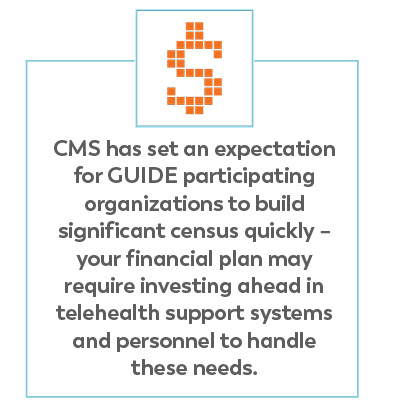Your GUIDE Model Application Has Been Accepted – Now What?
So, you applied to GUIDE. You have heard from CMS that you have been accepted! Congratulations! Now, what do you do?
CMS recently let approved applicants know they had been selected for the innovative Guiding an Improved Dementia Experience (GUIDE) Model. As this is the only announced application window for the eight-year pilot program, it is essential the providers who have been approved are prepared to launch an effective and sustainable care model when operations begin on July 1, 2024. Whether you have been assigned to the established program track or the new program track, time is short to develop the care model development plan that will lead to the positive patient outcomes CMS requires and to set your organization up for success over the long term.
It is essential to develop an agency-wide readiness plan to ensure your staff can provide excellent support for the new dementia patient populations that GUIDE stipulates. This will require all aspects of your organization to respond and, as this work is tremendously interconnected, a strong communication plan to avoid pitfalls.
Too often when adding a service line, such as GUIDE, we focus almost exclusively on the clinical program development pieces and not as much on all the supportive, administrative work that must happen for the program to be successful. This can result in the non-clinical departments playing “catch-up” after a new program launch, perhaps creating resentment as well as the need to make changes after the fact instead of building the necessary processes in from the start.
Here are some logistics to consider for your various departments:
- Leadership: Integrate GUIDE into your existing organizational structure with clear oversight and accountability pathways to ensure it has a balanced role at your leadership table; inform internal leaders of all relevant aspects of the GUIDE program and how it will impact their roles and other service lines; address how GUIDE fits with the mission of the organization as a concept and how it will be incubated and ultimately integrated into the overall organization; explore external partnerships to further enhance the provision of GUIDE services, especially in the areas of caregiver education, respite and community-based organization support.

- Finance/Billing: Develop an independent budget for GUIDE that supports program sustainability and takes all ancillary expenses – and benefits – into account; build policies and procedures for the billing requirements for GUIDE; develop productivity and utilization standards.
- Human Resources: Create job descriptions for all members of the GUIDE team, including expected caseloads, time expectations and performance metrics; if sharing staff with other service lines, adjust performance expectations accordingly; develop GUIDE-specific hiring strategies and staff scaling trigger metrics as needed.
- Marketing: Build educational and promotional materials specifically for the GUIDE program; integrate GUIDE into overall agency marketing materials; identify and reach out to potential referral sources and key stakeholders to proactively inform them of the GUIDE program; gather patient/family responses to the GUIDE program once it is running; think about continuum strategies for how GUIDE participants may transition from the program into adjacent programs, such as palliative or hospice as eligible. This also may be an important moment to make sure your brand architecture supports the addition of a service line that is not specific for end of life.
- Professional Education: Either develop an internal education support system for GUIDE caregivers as specified by CMS and/or collaborate with external education providers to ensure caregiver education requirements are met; develop GUIDE-specific staff education for all new GUIDE staff and ongoing. If you need a referral, let us know. We can recommend a provider.
- Customer Service/On-Call: Develop a standardized greeting and response when receiving communication related to the GUIDE program; consider assigning a specific phone number just for the GUIDE program to allow for specific response procedures and GUIDE on-call coverage access; create communication pathways for key staff within the GUIDE program. Again, make sure your brand infrastructure and communications processes support people who are not exclusively seeking end-of-life care.
- Board/Oversight: Become educated on the parameters of the GUIDE program and how it fits into the overall mission of the organization; establish a routine check-in process on the status of the GUIDE program, including finances and organizational metrics; provide guidance as needed.

- IT: Ensure that all GUIDE staff have adequate access to the EMR and other necessary technology; support billing process changes for Part B billing; support the development of GUIDE-specific charting templates and assessment access, especially regarding the need to chart on both the patient and the caregiver; consider accessing a Health Information Exchange to keep GUIDE staff informed of changes in patient status; support the creation of automated data-collection processes to empower quality assurance; support the creation of any necessary consent or data collection forms specific to the GUIDE program.
- Quality Assurance: Develop GUIDE-specific program metrics for all aspects of the program, including productivity, quality, outcomes, utilization and contract requirements; create policies and procedures regarding collection and monitoring of these metrics.
- Clinical: Create a clinical workflow inclusive of all aspects of care from referral to post-discharge follow-up; set parameters for what is in scope and out of scope of the GUIDE care plan; develop a strategy for the 24-hour telephonic coverage requirements of GUIDE, including consideration of other on-call capabilities of the organization; establish GUIDE-specific charting templates taking into account the need to chart on both the patient and the caregiver; fully integrate the community navigator role into the clinical workflow, maximizing their involvement and case management capabilities; integrate all required assessment tools into a standardized workflow, facilitate caregiver education access and re-enforce that education as needed; create process to access sources of caregiver respite, either internal and/or external, as well as triggers for putting such respite in place; maintain constant communication with the entire GUIDE team – clinical and non-clinical – throughout the care process.
There will be additional development areas based on the unique position of your organization, but this should serve as a broad review tool to help your team build an inclusive readiness plan. As questions arise, consider reaching out to CMMI at GUIDEModelTeam@cms.hhs.gov or connecting with Transcend Strategy Group at hello@transcend-strategy.com for support.










